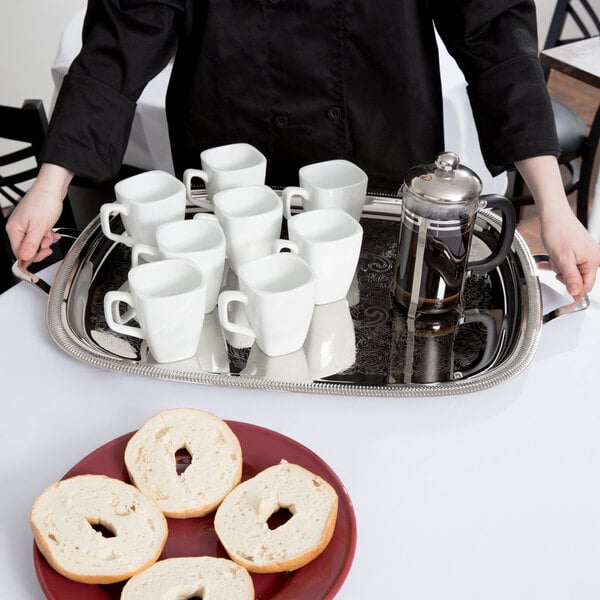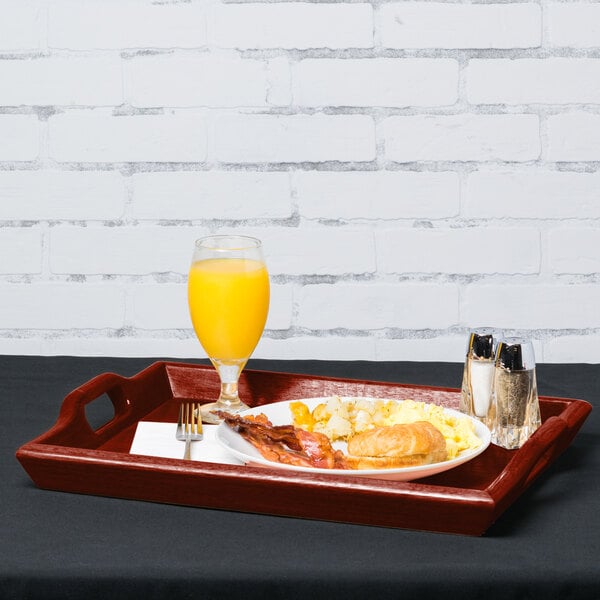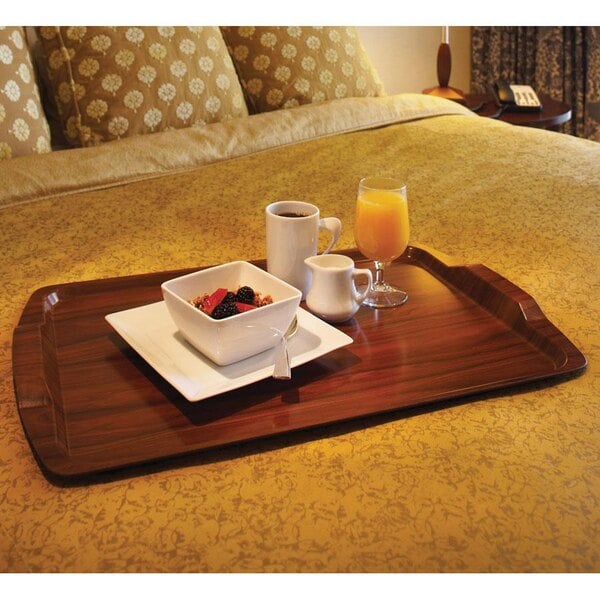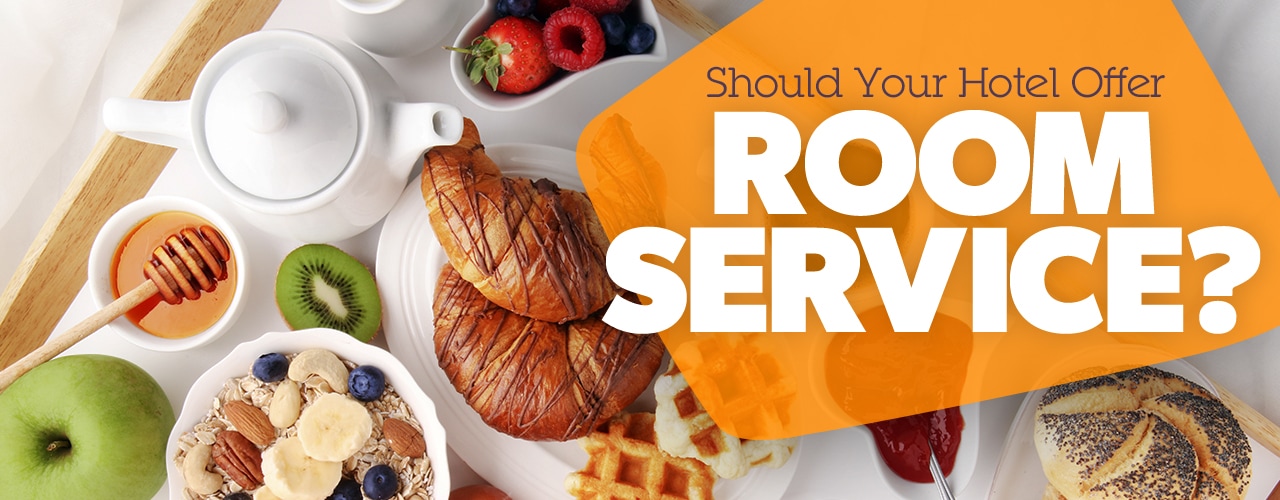How to Make Room Service Profitable
Last updated on Feb 26, 2024Corrinn McCauleyRoom service has long been a staple in the hospitality industry, offering guests the convenience of enjoying a meal in the comfort of their own room. However, it can often be a challenge for businesses to make room service a profitable venture. No matter what type of hotel you operate, with the right approach and a focus on efficiency and customer satisfaction, it is possible to turn room service into a lucrative revenue stream. Below we delve deeper into how room service works and how you can optimize your room service to maximize profits for your establishment.
What Is Room Service?

Room service is a hotel amenity that allows guests to order food and drink to their rooms. Hotel staff arrange the meal with the appropriate dishware and condiments on a room service tray. It’s an in-room dining best practice to offer guests a rolling room service table in case they don’t want to eat in bed.
How Does Room Service Work?
Traditionally, customers placed their orders by calling the front desk, but modern hotels have an online app customers place their orders through. While the hotel's kitchen staff fills the order and prepares the meal, the room service waiter sets up the hotel tray and/or trolley.
The room service waiter loads the meal onto the tray and brings it to the appropriate room. After the customer is finished with their meal, the hotel must decide how they want to handle the clearing of room service dishes. Some instruct guests to telephone when they want their dishes cleared, others allow guests to leave their dishes in the hallway. The latter option offers convenience for the guest who ordered the meal but forces other patrons to walk past discarded food scraps and dirty dishes.
How to Increase Room Service Profits
Hoteliers are in a difficult position; guests still want in-room dining, but traditional room service isn’t profitable. Typically only a small portion of hotels earn significant revenue from room service, but many travelers are still using in-room dining amenities. Thankfully, there are ways you can upgrade your operation to increase its profitability. Discover some options your establishment can utilize to save money and better satisfy your customers’ desires below:
1. Use Menu Engineering
If you choose to maintain the standard room service structure, strategic menu engineering can create a stronger allure. Guests are more likely to consider room service if it’s advertised in the hotel lobby and their room.
Once you have their attention, more guests will convert to room service customers if your menu is concise and scannable. A well-designed menu that aligns with aesthetic trends will create a better impression.
2. Make the Most of High-Tech Ordering

Allowing your hotel guests to order digitally can boost room service sales. Digital ordering eliminates confusion caused by language barriers and/or hearing impairments, which is significant since international travelers and guests with disabilities are some of the most common room service patrons. Across demographics, digital ordering circumnavigates the awkwardness and hold-times associated with phone orders.
3. Streamline Breakfast
Both leisure and business travelers want a convenient breakfast option before they start their day, which can create a morning service rush. To avoid long wait times and frustrations, encourage guests to place their in-room breakfast orders the night before so you can prepare them in advance. Business guests and travelers with early flights will appreciate the increased speed. If you have an on-site restaurant, give breakfast order forms to dinner guests and encourage them to fill them out at the end of their meal.
Alternately, you could choose to forgo room service and offer a complimentary continental breakfast instead. Spend the money you save on room service staff payroll and operating supplies on a simple, free breakfast all your guests can enjoy. Hotels that offer free breakfasts often attract more customers, receive more positive reviews, and retain their clientele.
4. Upselling
When it comes to making room service profitable, one strategy that should not be overlooked is upselling. Upselling is the practice of persuading customers to purchase additional items or upgrade their order, ultimately increasing the overall revenue generated from each room service transaction. By understanding your customers' needs, training your staff, offering enticing promotions, highlighting premium options, and personalizing recommendations, you can increase the average order value and maximize revenue from each room service transaction.
5. Provide a Grab and Go Service
You may opt for a hotel mini mart over offering room service. This gives guests access to food options at odd hours or when it is not convenient to go out to eat. Another option is to offer a limited grab and go menu that guests can order from and pick up in the lobby.
6. Partner with Restaurants
Outsourcing is one of the most popular room service revolutions. Hotels are partnering with delivery services and local restaurants to offer food for their customers. Since sampling regional cuisine is a beloved part of travel, hotels are creating curated menus featuring the bestselling food items from their local restaurants. Hotels that outsource their room service match the restaurants’ pricing and add a small delivery fee.
With this service, guests can order their food through the hotel staff or an online app and have it delivered to the lobby. A staff member will then transport the food to the guest’s room. This option provides guests with the same conveniences of room service while eliminating the need for an on-site kitchen. It also protects you against the safety concerns associated with third-party delivery personnel roaming your hotel's hallways. While outsourcing room service may not provide your hotel with additional revenue, it won’t drain resources either, and it often increases overall customer loyalty.
7. Give Your In-Room Dining Service a Luxury Boost
You can take your room service amenity to the next level by preparing a menu filled with local delicacies and unique options. Some hotels are increasing the extravagance of their room service experience by inviting celebrity chefs and mixologists to prepare meals. Resorts and luxury hotels may turn their food deliveries into theatrical experiences. These decadent boosts help hotels earn social media exposure.
8. Harness the Power of Rewards Programs
Offer a hotel rewards program and allow guests to earn points by ordering room service. Not only will this increase the number of in-room dining orders you receive, it allows you to build brand loyalty through your room service amenity. A study by The Centre for Hospitality Research discovered that hotel loyalty program members increase their number of stays at the hotel or its affiliated locations by 49%.
Back to TopTypes of Room Service
There are three main types of traditional room service: centralized room service, decentralized room service, and mobile room service. We examine what you need to know about each type of room service below:
- Centralized Room Service — Hotels with centralized room service process all their orders in their main kitchen and have a common team of servers who deliver meals to guests’ rooms.
- Decentralized Room Service — Some large hotels decentralize their room service by having separate pantries on different floors. Filling guests’ orders from a pantry on or near their floor expedites serving times and improves food quality.
- Mobile Room Service — Sprawling resorts may require a mobile room service operation. They use a van to deliver guests’ orders to the cottages and/or suites on their property.
Who Orders Room Service?

Just like bed and breakfasts are popular amongst leisure travelers and honeymooners, room service has its own target audience. Upscale and mid-scale hotels receive the most room service orders, and almost half of the leisure travelers patronizing upmarket properties order room service during their stay.
There are four primary groups who use in-room dining services:
Why Do People Order Room Service?
Ease and convenience motivates two out of every three room service orders. The desire for luxury is the smaller but still noteworthy motivation for ordering room service. Understanding why hotel guests order room service allows you to tailor your in-room dining amenity to their needs.
Pros and Cons of In-Room Dining
Room service can play a vital role in your guests’ experience at your hotel. However, in-room dining is often less glamorous than it’s portrayed and less profitable than it’s perceived. We break down the pros and cons of offering room service at your hotel:
Benefits of Offering Room Service at Your Hotel
- Room service can help you gain hotel stars, since three-, four-, and five-star hotels must have accessible food options.
- Provides a non-strenuous dining option for guests with disabilities.
- Offers meals to guests traveling and working at odd hours.
- Valuable in remote areas with limited dining options.
- Room service is an important aspect of recognized full-service hotels.
- Safe and comfortable dining solution for solo travelers.
- Appreciated service in case of inclement weather.
- Allows business guests to nourish themselves without pausing their work.
Downsides of Offering Room Service at Your Hotel
When Should You Offer Room Service?
We help you determine the most profitable times to operate your room service amenity below.

- Breakfast Room Service – Luxury hotels can fulfill patrons’ dreams of enjoying a decadent breakfast in bed by offering room service during breakfast hours. If you manage a mid-priced hotel that primarily serves traveling businesspeople, consider offering to-go style breakfasts such as yogurt parfaits, breakfast sandwiches, and scrambled egg burritos.
- Lunch Room Service – In most cases, offering room service during lunch hours isn’t profitable. Typically, vacationers and businesspeople spend their afternoon hours at attractions and conferences and won’t eat lunch in their rooms. If you’re a luxury hotel that offers 24/7 room service, consider offering charcuterie boards.
- Evening Room Service – Evening hours are profitable for mid-priced hotels that attract a lot of traveling business clientele. Businesspeople often travel solo, making them wary of the compromised safety and awkwardness associated with finding dinner in an unfamiliar city, so they appreciate having their dinner delivered to their room.
- 24/7 Room Services – Many five-star hotels offer around-the-clock room service to cultivate an atmosphere of luxury for their guests. If you’re a 3- to 4-star hotel operating in a night-life district, you would do well to offer room service throughout the night. Tailor your late-night menu to pub grub bestsellers like pizza, burgers, and loaded fries.
- Room Service During Your Hotel Restaurant Hours – If your hotel has a restaurant, you can mitigate operational costs by offering room service during restaurant hours. Having restaurant staff prepare room service and in-person orders side-by-side reduces the number of staff required. Offering the entirety of your hotel restaurant’s menu makes in-room dining more appealing for customers who want options. Limited room service menus cause many patrons to turn to third party delivery apps.
Room Service Food

Delivery menu best practices apply to room service offerings, so make sure your food items travel well while keeping in mind that guests choose room service for its convenience and luxury. Your room service amenity is competing with popular delivery apps, which provide equal convenience, so you must outdo them in speed and luxury.
Top 5 Food Items Delivered to Hotel Rooms
- Burgers
- Club Sandwiches
- Pasta Dishes
- Caesar Salads
- Fries
Top 5 Beverages Delivered to Hotel Rooms
- Orange Juice
- Coffee
- Cola
- Water
- Beer
Of course, the order preferences of guests vary by hotel type. City hotels have the most burger and orange juice orders, and design/lifestyle hotels receive the greatest number of fry orders. Hotels that host meetings, incentives, conferences, and exhibitions (MICE hotels) receive the most cola beverage orders.
Back to TopRoom Service FAQs
We answer some of the most common room service questions and topics below:

How Long Does Room Service Take?
When it comes to room service, one of the most common concerns for both hotel guests and staff is the time it takes to deliver the food. Typically room service is delivered within an hour of ordering, but factors such as menu complexity, order volume, and distance from the kitchen can result in varying wait times. As a hospitality establishment, it’s critical that you deliver room service to guests at their earliest convenience.
Do All Hotels Have Room Service?
While room service is a common feature in many hotels, it is not a standard offering in every establishment. The availability of room service depends on various factors, including the size and type of the hotel, its location, and the target market it caters to. It's important for operators to consider the demand for room service within their target market and assess whether it aligns with their overall business strategy. While room service can be a profitable amenity for hotels, it requires careful planning and investment to ensure its success.
Room Service Amenities
One way of providing an exceptional experience that goes above and beyond customers’ expectations is by offering a range of amenities that enhance their stay and make them feel pampered. Stocking the mini-bar in each room with a variety of snacks and beverages is a great way to generate additional revenue. Additionally, offering an in-room coffee or tea station allows guests to enjoy a hot beverage at their convenience.
Back to TopMaking room service profitable is all about efficiency, technology, exceptional service, and smart pricing strategies. Positioning your room service for success helps ensure the service is a valuable revenue stream rather than a drain on resources. Additionally, a high-quality room service can be a huge boon to guests, boosting your establishment’s reputation by offering convenience and high-quality service.



